Initial massing and density studies have been presented for the potential redevelopment of multiple Cabrini Green sites within the Near North Side. Roughly bound by W Chicago Avenue to the south and W Schiller Street to the north, if fully completed the project will eventually replace multiple vacant lots near downtown.
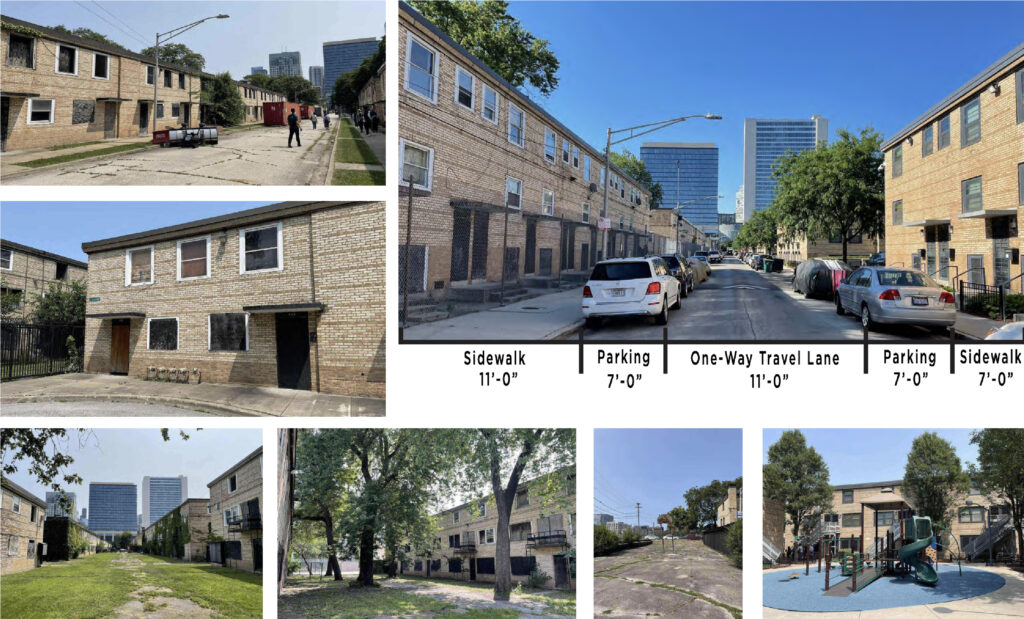
Current views of Cabrini Green by SCB
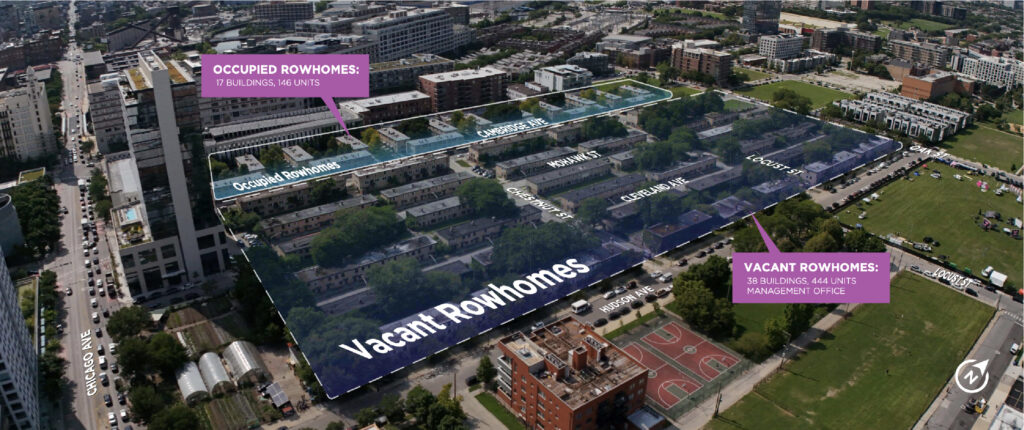
Current layout of Cabrini Green by SCB
Efforts for the redevelopment are being led by the Chicago Housing Authority who built, ran, and demolished the original Cabrini Green complex. Perhaps one of the most famous housing projects in the nation, it was completed in 1962 and housed around 15,000 people across high rises and row homes. However due to neglect from the CHA it quickly fell into disrepair.
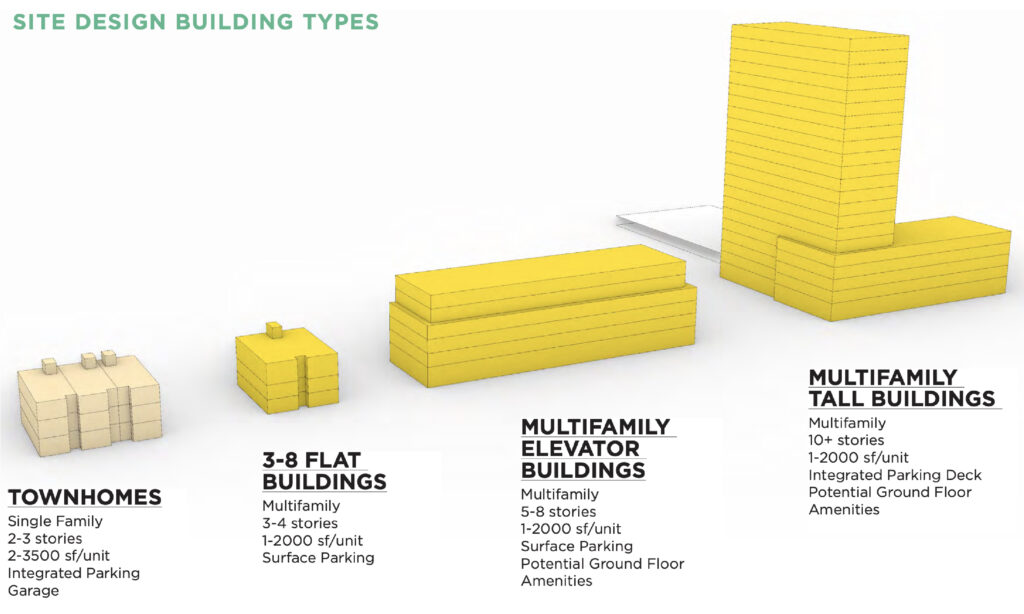
Building typology diagram for Cabrini Green redevelopment by SCB

Site plan of Cabrini Green redevelopment by SCB
Phased demolition on Cabrini Green commenced in 2015, leaving acres of empty land behind and a large portion of the origins row homes which sit mostly vacant. Now after multiple attempts, CHA has returned with multiple new master plan concepts designed by local firm SCB and presented to the community late last month. They are as follows:
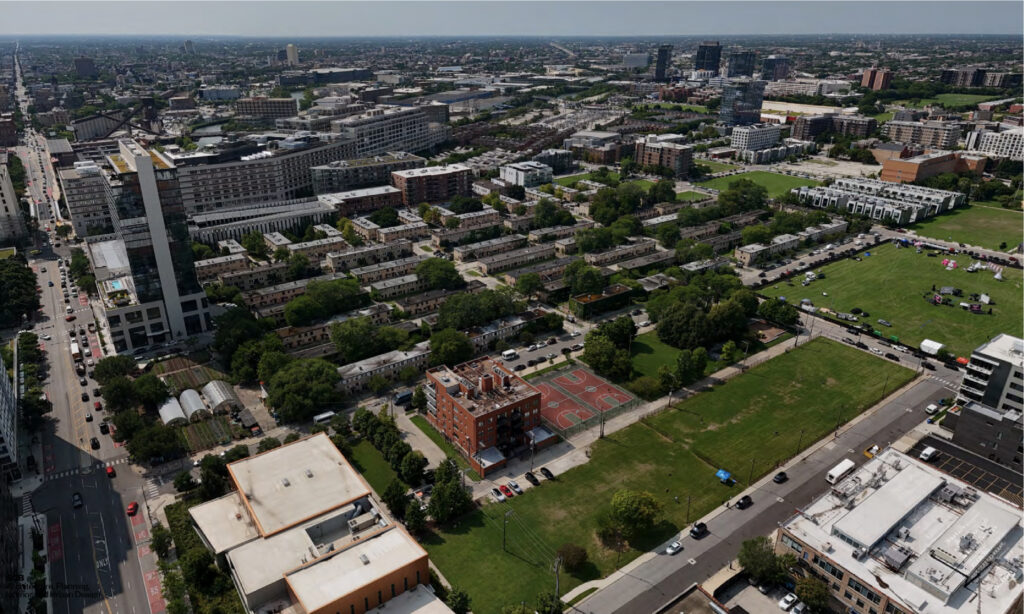
View of southern sites for Cabrini Green redevelopment by SCB
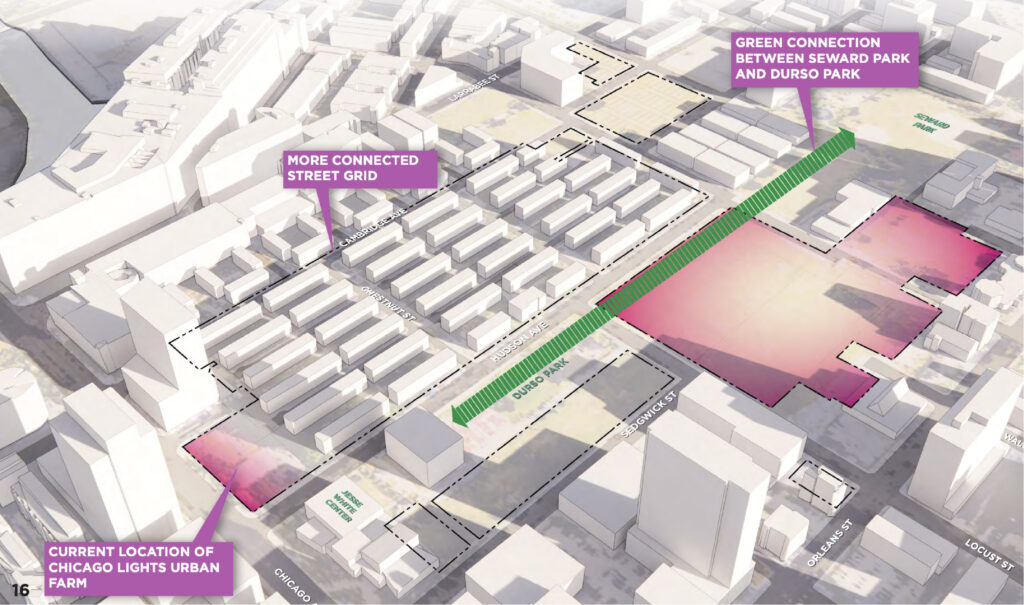
Current site plan of Cabrini Green south sites by SCB
Southern Sites
Stretching from Chicago Avenue on the southern end to Oak Street to the north, this portion spans nearly 30 acres of land including the existing vacated and occupied row homes. This portion of the development will focus on connecting Durso and Seward Parks, adding higher density structures along the edges.
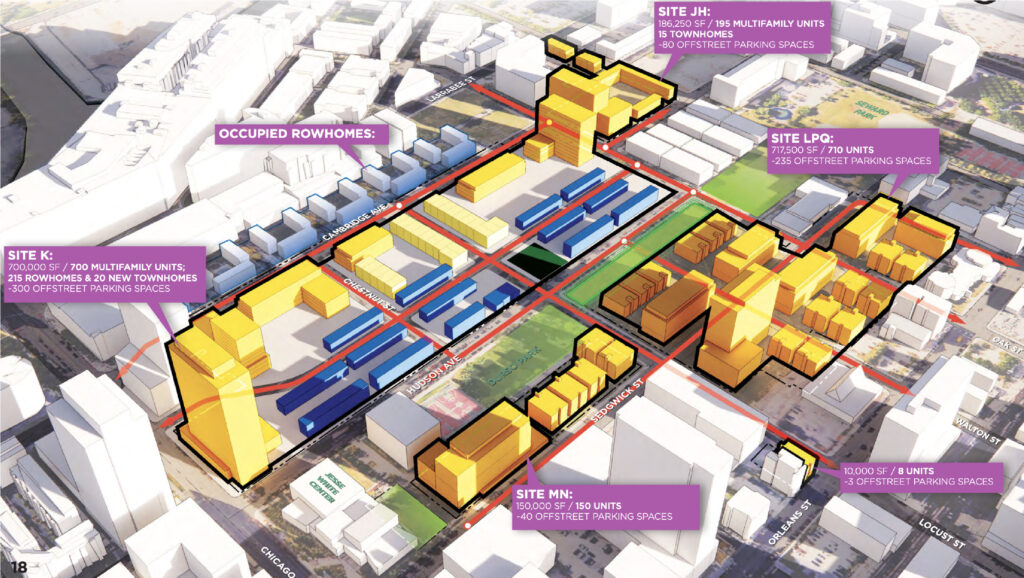
Strategy one site plan of Cabrini Green south sites by SCB
Strategy One – 2,005 Units – 655 Parking Spaces
The most intensive of the options, this will reroute and expand the existing roadways for improved connectivity. Work will start with the preservation of the occupied rowhomes, then it will renovate and preserve 14 of the vacant rowhomes with 215 units, add 35 new townhomes, and build 1,940 multi-family units.
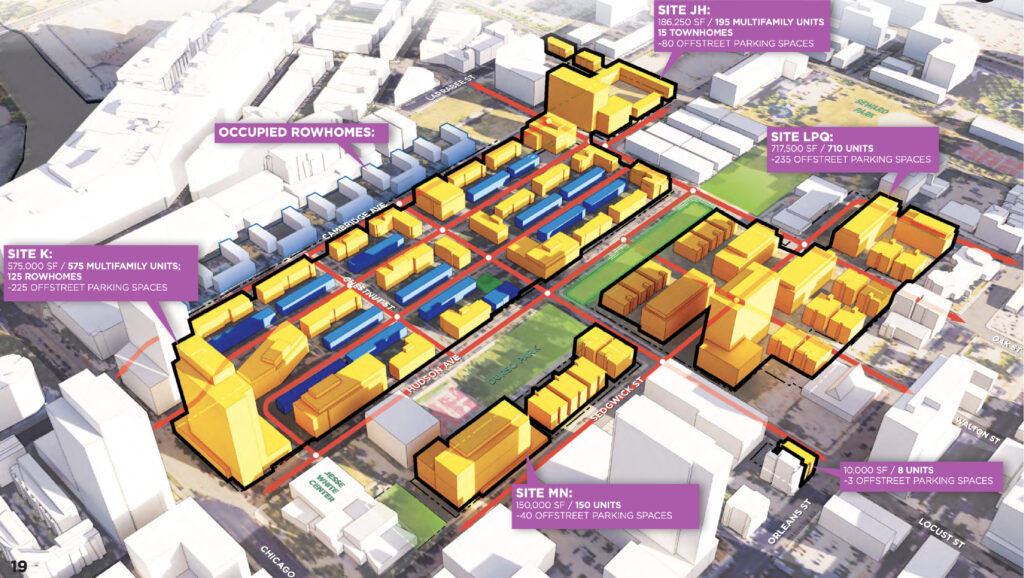
Strategy two site plan of Cabrini Green south sites by SCB
Strategy Two – 1,770 Units – 580 Parking Spaces
The least dense of the three options, this will preserve the existing street layout while connecting them back to the main roads. Similarly, it will preserve the occupied homes, but preserve 14 different existing rowhomes with 125 units. This will be followed by 15 new townhomes and 1,985 multi-family units.
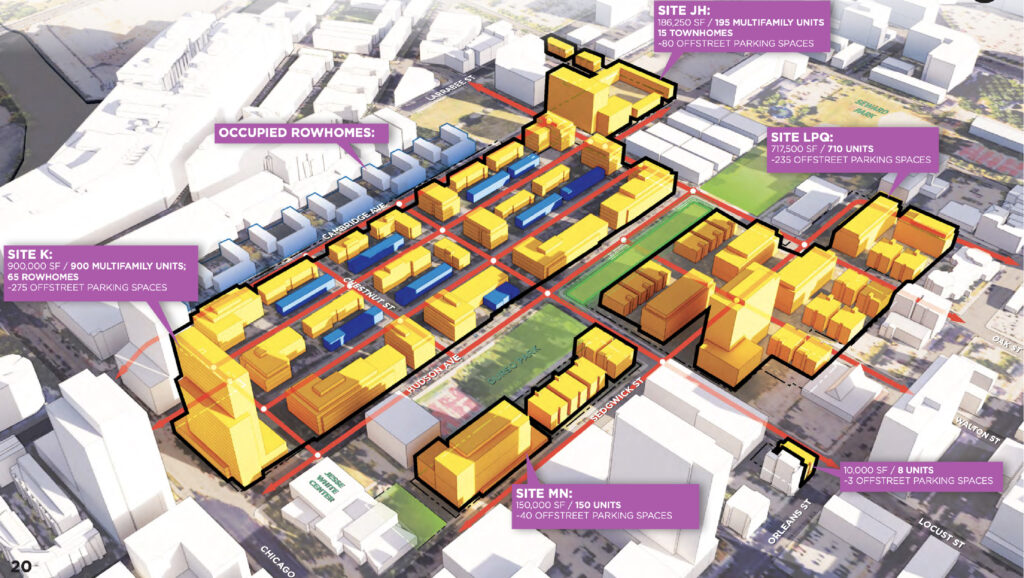
Strategy three site plan of Cabrini Green south sites by SCB
Strategy Three – 2,035 Units – 630 Parking Spaces
The most dense of the three, this will take a similar approach as the second and preserve much of the existing street grid. Also saving the occupied rowhomes, it will only preserve eight of the existing rowhomes with 65 units. Meanwhile it will construct 15 new townhomes and around 1,970 multi-family units.
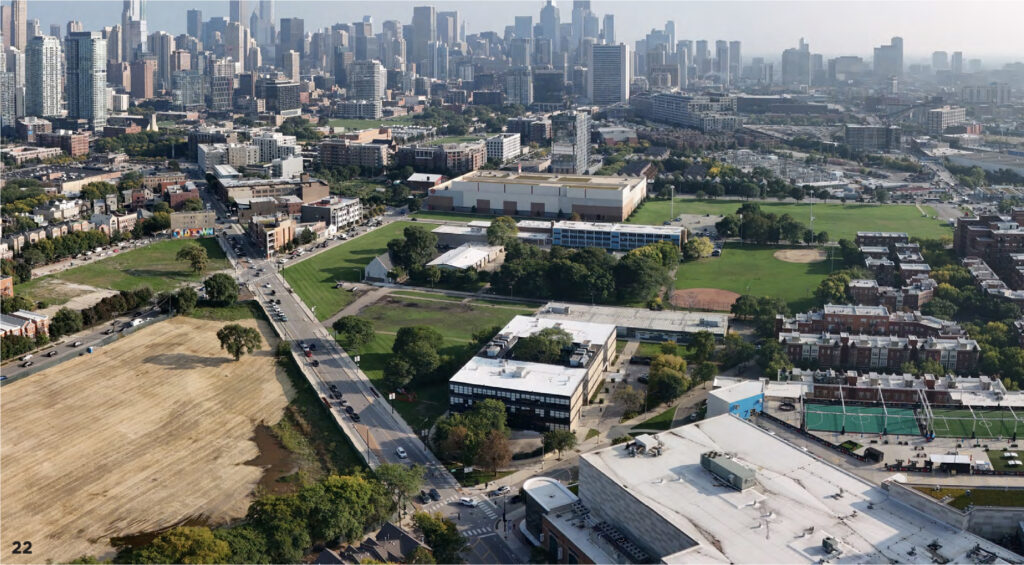
View of northern sites for Cabrini Green redevelopment by SCB
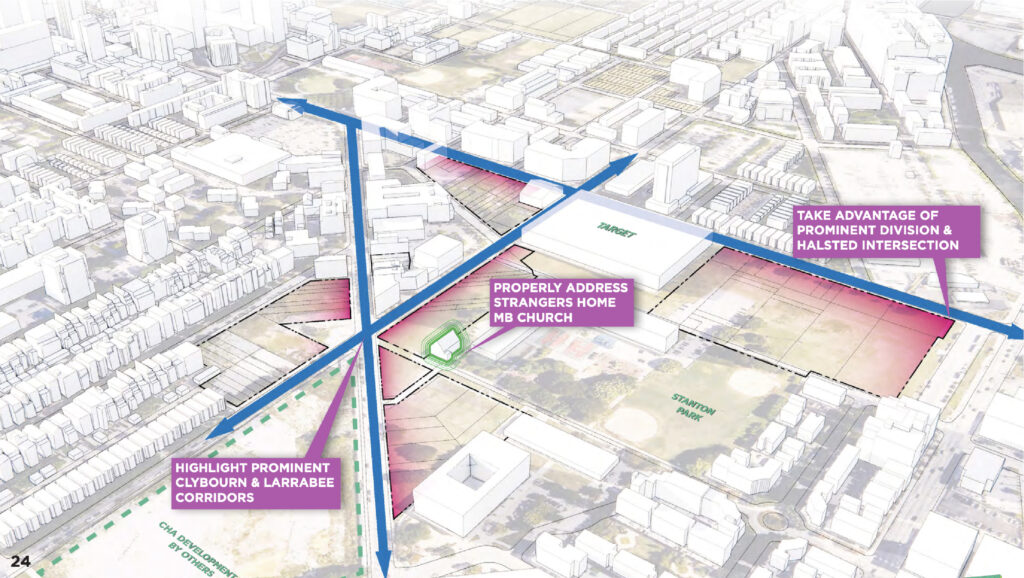
Current site plan of Cabrini Green north sites by SCB
Northern Sites
Centered around Division Street and the intersection between Larrabee Street and Clybourn Avenue, this portion spans around 17 acres near the existing Target and upcoming development at 1450 N Larrabee Street. These will preserve Strangers Home MB Church as well as create new pocket parks.
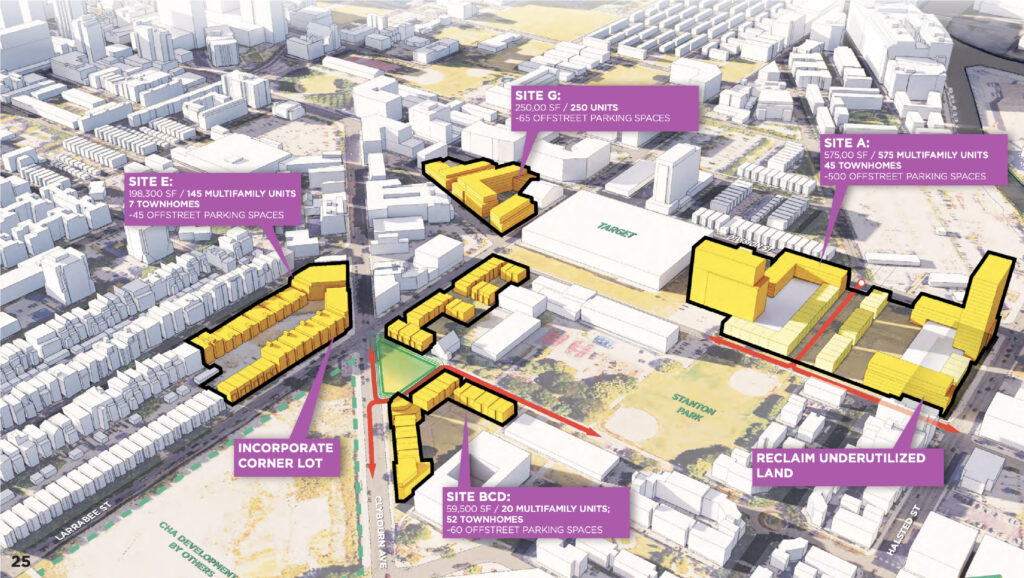
Strategy one site plan of Cabrini Green north sites by SCB
Strategy One – 1,050 Units – 565 Parking Spaces
The least dense of the three, this will focus on low-rise structures including 104 townhomes and 946 multi-family units. With 1.2 million square feet of space and 0.3 acres of green space, CHA expressed that this option will have less units than the market suggests thus may not pencil out financially.
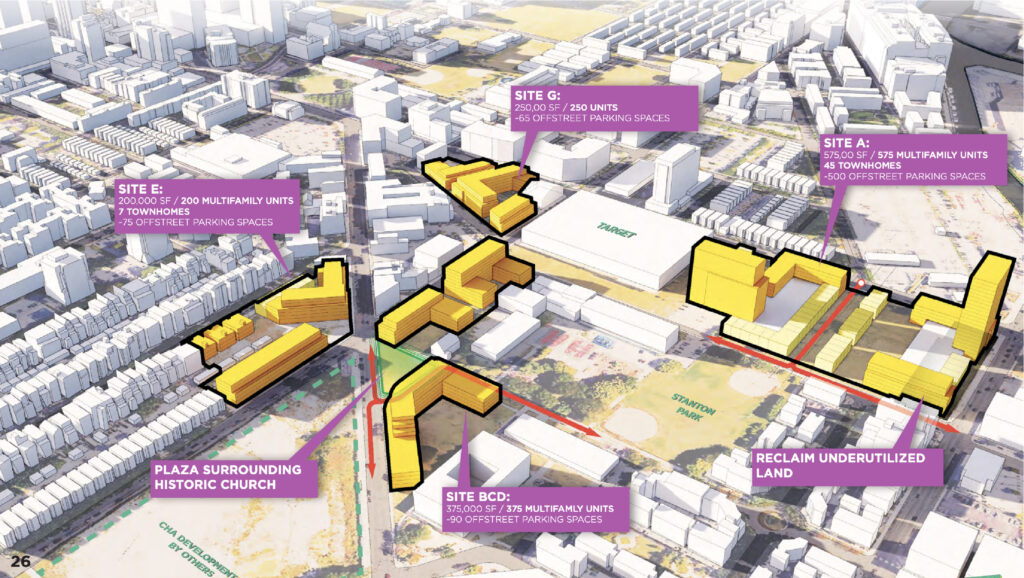
Strategy two site plan of Cabrini Green north sites by SCB
Strategy Two – 1,450 Units – 730 Parking Spaces
This middle ground proposal will focus on elevator buildings and mid-rises. This will bring 1.5 million square feet of space across 50 new townhomes and 1,400 multi-family units, complemented by 0.3 acres of green space. Similar to strategy one, this will come in the form of a small plaza in front of MB Church.
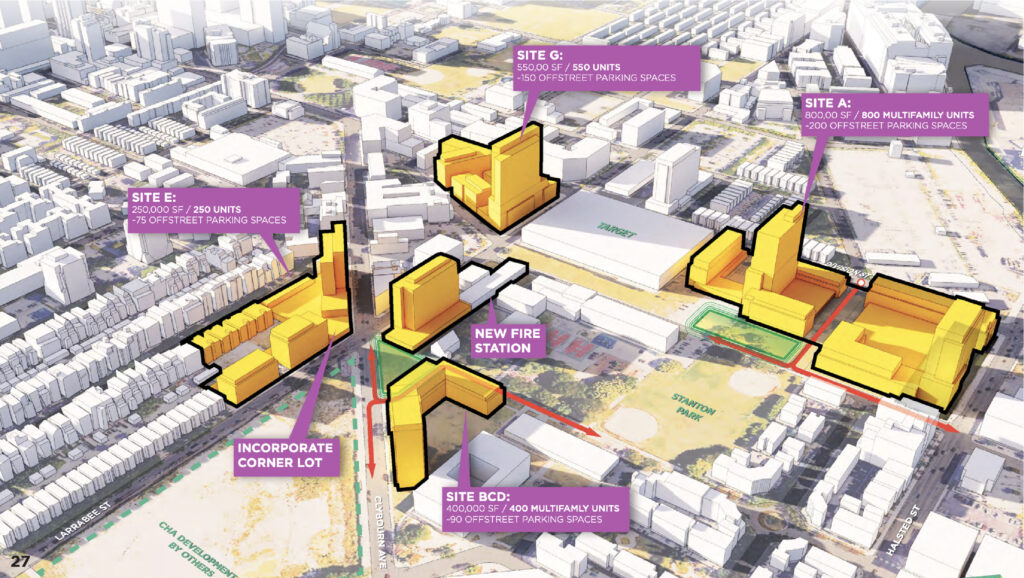
Strategy three site plan of Cabrini Green north sites by SCB
Strategy Three – 2,000 Units – 515 Parking Spaces
The most dense option with the least amount of parking, this will bring multiple new mid and high-rises with all of the units being multi-family. In total there will be 1.9 million square feet of space and one acre of green space with an addition to Stanton Park. However due to the density it will need to include a fire station which may complicate things.
After a handful of community meetings, locals expressed their preference for elevator buildings and mid-rises over taller structures though the area is being built out much taller. With these proposals being public, the design team will make refinements for a third meeting in the falls. A final masterplan is expected to be submitted by November of this year.
A presentation of the options can be found here.
Subscribe to YIMBY’s daily e-mail
Follow YIMBYgram for real-time photo updates
Like YIMBY on Facebook
Follow YIMBY’s Twitter for the latest in YIMBYnews


near northside nimbys have WAY too much control over development. im sick of watered down housing plans in such key areas, it holds chicago back
I hope they hold this back. Cabrini Green was a mess. I don’t understand how rebuilding it will solve anything. Public housing doesn’t work. It doesn’t work in the UK, it doesn’t work in Sweden, it doesn’t work in Canada…places that have stuff figured out haven’t figured out public housing. And the City of Chicago doesn’t have anything figured out. What a nightmare in the planning.
Well that’s just patently false. It’s complex yes, but most people in Vienna live in social housing, rich and poor and everything in between.
That’s not true, yes, 60% of people in Vienna live in government owned buildings but they still need to have income to apply for those, not a free housing. And no, rich people don’t live in those. Also major difference between Vienna and Chicago is that being poor there doesn’t come with shootings, carjackings, robberies etc
I wish I could link to stuff in these comments, because maybe 2 winters ago the NY Times did a long piece on this. And it covered how many people who do not need assistance live in these places. They actually interviewed some of them, so I’m not sure where you’re getting your info.
No, Chicago (or any US city for that matter) is not Vienna, but robust social housing (i.e. a *high quality* social safety net) is a very important part of Chicago being able to become more like Vienna instead of less like it.
Vienna? lol.
This looks completely different from the original Cabrini Green design, which was bad by design except for the rowhomes that are still being successfully inhabited. Keep the fear mongering up though, it’s great
I’m speechless.. preserving occupied row homes? I bet whoever wrote this never stepped foot on that street and haven’t even lived nearby to see how often police called in and how much crime is spills out of only 146 units across occupied rowhomes, not even talking about condition of those buildings. The only adequate solution is to finish the job and bulldoze everything down, sell the land and let private developers build quality housing with higher percentage of affordable, not free units, so it’ll house people who holds a job. But let’s be real.. we live in Chicago and CHA will find the way to screw everything up. 🤦🏻♂️
Any development near those townhomes would fail imo, until the people living in them are long gone. Public housing attracts the lowest common denominator in the USA and the USA will likely never reach the point where they are respectable people. This isn’t Vienna or Sweden like mentioned above.
Get rid of the CTA and replace with 100% private development.
Whatever happened to scattered site mixed income infill housing?
So much for YIMBY among the comments…
welcome. you must be new here
Renovating old units is far more cost-effective than building them brand new, and CHA needs to meet the high demand for affordable housing that we are seeing in the city. Therefore, they should preserve the townhouse units to get more units online citywide. Frankly, given that Chicago’s population has been stagnant for so many years, I don’t think we need the densest option. Preferential to Strategy 1 for the South parcels and Strategy 2 for the North parcels
There appears to be a misunderstanding of the development here. It isn’t clear as to what type of development is being proposed by the text, but CHA has already developed many mixed income projects all over the city already without the bad outcomes that we saw with projects like the old Cabrini Green. There are already buildings in and around Division that have been developed by private developers with CHA that most people wouldn’t know is mostly affordable housing. I think people are reacting to past models for housing that no longer hold true. This master plan is mostly talking about the density issue. I think this model of mixing market rate and different levels of affordable works.
Shhh… don’t tell the hair pullers.
Don’t you know mixing housing with the poors leads to nothing but exponential crime?
How on earth did we live together before the failures of urban renewal…?
Thank you for having some sense. It’s like half of these commenters didn’t know all this land has been owned by CHA since before all these new developers ever showed up… I’m sure all the developers in this area knew it was a matter of time before CHA would build something here again, yet you don’t hear them complaining
Tear all that garbage down and get HUD, CHA and every other do nothing poverty grifting agency out of it and return the land to private, market rate ownership. Everything the government touches turns to trap especially in Chicago and IL. Want lower housing cost then let the market build unencoumbered, then police it and prosecute the criminals. Really easy to understand.
This thinking will never fly in Chicago, the population is too many generations into the brainwashing.
But private, market rate development was good enough to build the environment that we all cherish (and lament when developers tear it down) and try to preserve. But for some reason, it isn’t good enough now.
WOW what a step backwards! Chicago never learns from the past and so it repeats!!! With the huge already approved high rise in the Halsted and Clybourn area I bet those developers are crying! The higher floors will be looking at the new and approved projects. So much for that building to attract huge rents.
Let them cry, they don’t own the city and everyone knew CHA still owns land here. More importantly, this will be nothing like the old Cabrini, and it’s not hard to see why. This is more mixed income, and there’s already luxury buildings nearby compared to the old design which was isolated from the nearby neighborhood with giant seas of asphalt and terribly designed from the ground up to be soulless copies of the same high-rises with no security… compared to this design which only has a couple of high-rises and a much more community oriented design. You can cry about it all you want but if we don’t build affordable housing, Chicago will eventually end up like West coast cities that have their long time citizens turned homeless and still working the jobs that used to be able to support them.
I don’t agree. CHA is an outdated and bad idea.
There is plenty of affordable housing in Chicago. There is so much affordable housing in Chicago that it’s actually a problem. It’s just that too many people, including lower income people, don’t want to live there. They should live where they can afford to live, and stop demanding that the Government build them a place to live in the middle of downtown.
These comments tell me the majority of people on this site are just interested in development for the sake of money. People need a place to live and neighborhoods near downtown are becoming unaffordable to working class Chicagoans. You can talk about crime all you want but anyone who’s seen how much this area has gentrified in recent decades knows it won’t be anything like it was in the 20th century, along with almost any city center in the US. There’s far more police presence and security in the area, unlike the high rises which were all isolated from the nearby neighborhood like prisons, where police wouldn’t even bother stepping foot in. This new design is far more community oriented and interconnected. Yes, crime is still an issue and certain crimes like property crime have gone up but violent crime has gone down in many areas, especially in this area, and there’s no way it’s just going to descend into madness like it did before, for these reasons:
-The Cabrini high rises and other high rise projects were bad by design, this is no secret, and I highly doubt those same mistakes would even be allowed today. They were completely neglected in many cases, and security wasn’t even a consideration. That will be much different this time around with all the wealth in the area that wasn’t there before.
-The city operated much differently back then. The city more or less collectively agreed to let the Cabrini area and many other parts of the city go to shit by not enforcing laws and just letting it rot, while only caring for the wealthy parts of the city which back then were much smaller than today. Today, the city and police still have that same attitude, but now it’s towards areas on the far south and west sides, and not for areas in the city center like this (this also has to do with general trends in the US which brings me to my next point,)
-City centers in the US are much different than they were in the second half of the 20th century thanks to the suburban experiment. Like many cities, Chicago’s downtown and surrounding areas were very gritty environments, especially at night, because all the wealthy white people would be safe and sound in their office towers and suburbs. Now, we’re seeing the pendulum swing back in the other direction as young people move back into city centers, including Chicago which as a city is declining, but the city center has been growing for a while now.
Don’t agreement with the doomer bad faith NIMBYs. I’m glad something is finally going up here, love the higher density models. This area could use some affordable homes so close to downtown. Average workers deserve to live here without being called criminals.
Having lived in 3-4 different apartments north, east, and south of cabrini green I’d say it needs to be leveled.
I actually think it should be turned into a park. The area desperately needs high quality green space that connects the adjacent neighborhoods (river north, old town) and gives residents a place for recreation away from the tourist filled lakefront. Sure some of it could be developed, but a park would be extremely valuable and better looking than another podium building.
Anything the CHA and HUD touches will fail. Not if but when. It will cost 2 or 3 times as much as market rate, the taxes generated will be too low for the potential while using more resources, the land is tied up in state and federal encumburances that are impossible to remove once established. Think of these agencies as the parking meter deal but for housing, a terrible idea that once implemented can never be removed. I’m assuming the people cheering on these decades old perpetual failures of the worst of government beuracracy must be young and nieve. You want to help, you think you’re helping but you’re not. You’re giving a junky more Crack but this junky can’t die just take more and more. Scorched earth here is the only solution. Kill it with fire and salt the earth here.
Loving all of these option. And the addition of pocket parks would be extremely welcome. The area needs nice parks and affordable housing. Having lived in this area for many years it is far too empty given its proximity to downtown and great local amenities. I hope this moves forward soon.